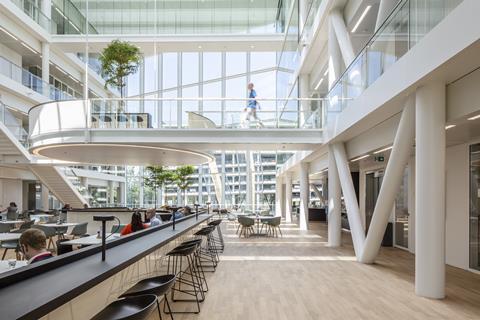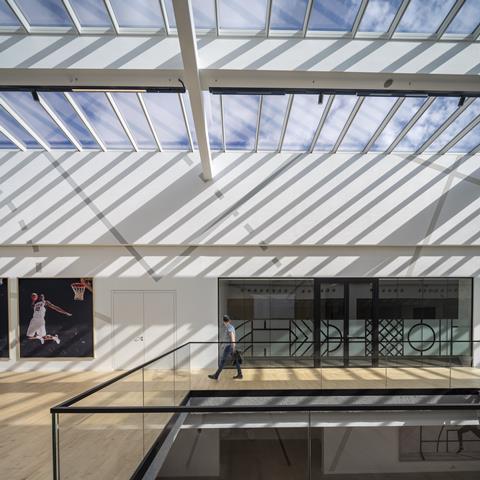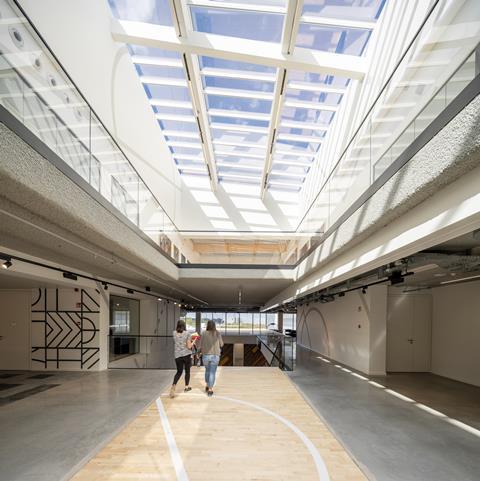
It’s easy to think of light as being required only for vision. After all, light levels are typically specified in terms of the level of illumination needed at a surface to allow people to work safely. Instinctively, we know that daylit spaces are more pleasant to live and work in, but many of us are frequently forced to rely on artificial lighting for illumination.
At the 2019 VELUX Daylight Symposium Kevin Houser, professor at Oregon State University, gave a presentation about human-centric lighting. He demonstrated how the phrase is a relatively new one having seemingly become a synonym for ‘lighting quality’ before soon replacing that term outright.
‘Human-centric lighting’ carries an element of meaning to do with health and wellbeing, in a way that ‘lighting quality’ doesn’t convey. By describing something as ‘human-centric’ it’s possible to market it in a different way and tap into the zeitgeist of being more people-focused and achieving healthier outcomes.
That ‘something’ can be lighting design services or artificial lighting products. As good as some artificial lighting is, however, no electric light source has yet been created that can match the quality of natural light or mimic the variation in its spectrum throughout the course of a day, a season, or a year.

Circadian rhythms
The hormone melatonin governs our pattern of wakefulness and sleep and the type of light to which we expose ourselves plays a role in managing the cycle.
Exposure to ‘cooler’ more distributed blue-rich light during the day suppresses the production of melatonin and maintains alertness by effectively encouraging the production of serotonin, dopamine and cortisol. Following this with ‘warmer’ and more focused light during the evening stimulates the release of melatonin and helps us to feel sleepy. This is our circadian rhythm.

Good lighting and true ‘human-centric’ lighting combines both visual and non-visual aspects to stimulate the correct physiological responses and promote good health. We need a daily daylight exposure because daylight is rich in the spectrum to which the non-visual system is most sensitive.
The greater the contrast between daytime and night-time light exposure, the greater the production of melatonin. More melatonin means more sleep signals for the body. At this point we need darkness. An absence of light at night is every bit as important to good daylighting as the correct light levels during the day.
To support this we can create indoor environments that not only provide a good visual experience and high levels of visual comfort but which are also in tune with the physiology of our circadian rhythms. In doing this we need to consider the role of natural light in human health and how buildings can be designed to achieve genuine human-centric daylighting throughout the building fabric.
Designing the building envelope to bring light to life
For any building’s lighting strategy to be considered truly human-centric, it should incorporate daylight as much as possible to provide well-lit, dynamic, and comfortable internal spaces. Not only does daylight provide a higher level of illumination, it also helps maintain the circadian rhythms of the building’s occupants.

Speaking at the 2019 VELUX Daylight Symposium, Vivian Loftness, of Carnegie Mellon University, presented on the concept of ‘environmental surfing’. She bemoaned the current poor state of commercial buildings and their lack of environmental resilience in the face of an uncertain future.
Vivian emphasised the need to make use of natural lighting, in order to rely less on artificial lighting and save money while reducing energy demand. She also presented case studies demonstrating how it’s possible to quantify design features like good daylighting, factoring in their positive economic impact in terms of improved health, comfort and productivity.
A human-centric daylighting approach not only improves the quality of spaces in buildings, it can also help reduce the payback of such design features from nearly a decade to just one year.
There is little doubt that daylight should be a significant component of a building design that claims to embrace human-centric lighting.
A new whitepaper from VELUX Commercial looks at this in more detail and considers how different parts of a building may be designed to correctly account for daylight to provide naturally well-lit spaces and support a commercial building’s ventilation strategy.
Download your free copy of our whitepaper Human-centric lighting: How the design of the building envelope can bring light to life here














No comments yet